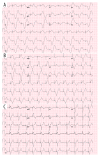Flecainide Toxicity Resulting in Pacemaker Latency and Intermittent Failure to Capture
- PMID: 31467262
- PMCID: PMC6735620
- DOI: 10.12659/AJCR.916370
Flecainide Toxicity Resulting in Pacemaker Latency and Intermittent Failure to Capture
Abstract
BACKGROUND Flecainide is a class Ic antiarrhythmic agent used in the treatment of supraventricular and ventricular arrhythmias. It is associated with a potent adverse effect profile; however, the effects of flecainide toxicity in the setting of a pacemaker have not been well described. We describe a unique case of flecainide toxicity secondary to acute kidney injury in the setting of a dual-chamber pacemaker, resulting in ventricular capture latency and intermittent failure to capture. CASE REPORT The patient was a 91-year-old female with a history of atrial fibrillation maintained in sinus rhythm on flecainide, who presented complaining of purple visual disturbances and syncope. She was found to be hypotensive and bradycardic, with a heart rate between 30 to 40 beats per minute. Lab work was notable for creatinine at 2.12 mg/dL. A 12-lead ECG demonstrated atrial and ventricular pacing with severely widened QRS complex and a significant latency between the pacemaker ventricular spike and the ventricular capture. The pacemaker was interrogated, revealing a significant increase in ventricular threshold from 0.75 V at 0.5 ms at baseline to 5.0 V at 1 ms to obtain consistent capture. After multiple boluses of IV sodium bicarbonate, the QRS acutely narrowed, latency interval improved, and consistent pacing capture was achieved. The flecainide level drawn on arrival was 3.09 mcg/mL. CONCLUSIONS Flecainide increases the ventricular capture threshold for pacemakers. Toxicity in these patients may present with pacemaker ventricular capture latency or failure to capture.
Conflict of interest statement
Figures


Similar articles
-
Flecainide causing elevated capture thresholds on pacemaker implantation.BMJ Case Rep. 2024 Mar 21;17(3):e259098. doi: 10.1136/bcr-2023-259098. BMJ Case Rep. 2024. PMID: 38514158
-
Flecainide-induced AV dyssynchrony and atrial latency progression in a patient with a dual-chamber pacemaker.J Cardiovasc Electrophysiol. 2021 Jul;32(7):2005-2010. doi: 10.1111/jce.15119. Epub 2021 Jun 10. J Cardiovasc Electrophysiol. 2021. PMID: 34053127
-
A case of acute ventricular capture threshold rise associated with flecainide acetate.Yonsei Med J. 2006 Feb 28;47(1):152-4. doi: 10.3349/ymj.2006.47.1.152. Yonsei Med J. 2006. PMID: 16502500 Free PMC article.
-
Flecainide acetate for the treatment of atrial and ventricular arrhythmias.Expert Opin Pharmacother. 2013 Feb;14(3):347-57. doi: 10.1517/14656566.2013.759212. Epub 2013 Jan 7. Expert Opin Pharmacother. 2013. PMID: 23294160 Review.
-
Canadian Cardiovascular Society atrial fibrillation guidelines 2010: rate and rhythm management.Can J Cardiol. 2011 Jan-Feb;27(1):47-59. doi: 10.1016/j.cjca.2010.11.001. Can J Cardiol. 2011. PMID: 21329862
Cited by
-
[Reversibility of a critical intraventricular conduction delay under flecainide and lacosamide by sodium bicarbonate].Inn Med (Heidelb). 2024 Aug 21. doi: 10.1007/s00108-024-01768-2. Online ahead of print. Inn Med (Heidelb). 2024. PMID: 39167189 German.
-
Flecainide causing elevated capture thresholds on pacemaker implantation.BMJ Case Rep. 2024 Mar 21;17(3):e259098. doi: 10.1136/bcr-2023-259098. BMJ Case Rep. 2024. PMID: 38514158
-
Cardiac Arrest Due to Pacing Failure From Pilsicainide Poisoning.Anesth Prog. 2023 Jun 1;70(2):70-74. doi: 10.2344/anpr-69-04-04. Anesth Prog. 2023. PMID: 37379093 Free PMC article. No abstract available.
-
Flecainide toxicity with high pacemaker capture thresholds and associated takotsubo syndrome.BMJ Case Rep. 2021 Aug 6;14(8):e243326. doi: 10.1136/bcr-2021-243326. BMJ Case Rep. 2021. PMID: 34362750 Free PMC article.
References
-
- Blomstrom-Lundqvist C, Scheinman MM, Aliot EM, et al. ACC/AHA/ESC guidelines for the management of patients with supraventricular arrhythmias – executive summary: A report of the American College of Cardiology/American Heart Association Task Force on Practice Guidelines and the European Society of Cardiology Committee for Practice Guidelines (Writing Committee to Develop Guidelines for the Management of Patients with Supraventricular Arrhythmias) Circulation. 2003;108(15):1871–909. - PubMed
-
- Fuster V, Ryden LE, Cannom DS, et al. ACC/AHA/ESC 2006 Guidelines for the Management of Patients with Atrial Fibrillation: A report of the American College of Cardiology/American Heart Association Task Force on Practice Guidelines and the European Society of Cardiology Committee for Practice Guidelines (Writing Committee to Revise the 2001 Guidelines for the Management of Patients with Atrial Fibrillation): Developed in collaboration with the European Heart Rhythm Association and the Heart Rhythm Society. Circulation. 2006;114(7):e257–354. - PubMed
-
- Saksena S, Camm AJ, Boyden PA. Electrophysiological disorders of the heart. 2012.
-
- Winkelmann BR, Leinberger H. Life-threatening flecainide toxicity. A pharmacodynamic approach. Ann Intern Med. 1987;106(6):807–14. - PubMed
Publication types
MeSH terms
Substances
LinkOut - more resources
Full Text Sources
Medical
Miscellaneous


